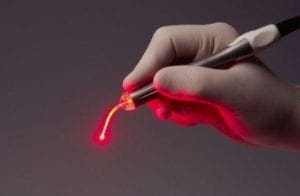Laser irradiation speeds up tooth movement?
There is currently a lot of interest in methods of speeding up the rate of orthodontic tooth movement. This new study shows that laser light irradiation has an effect. Let’s look at it critically.
I have posted before about methods to speed up tooth movement. My overall conclusion was that there may be an effect. However, much more research is needed. A team from Saudi Arabia, Pakistan and Malaysia did this study. The AJO published this paper.
Irfan Qamruddin et al
AJO-DDO: DOI: http://dx.doi.org/10.1016/j.ajodo.2017.03.023
They set out to answer the following question;
“Does the application of low level laser light therapy (LLLT) influence the velocity of tooth movement and reduce orthodontic pain”?
What did they do?
They ran a single blind randomised clinical trial with the following PICO:
Participants: Orthodontic patients aged 12-25 years with Class II Division 1 malocclusion requiring bilateral extraction of first premolars.
Intervention: LLLT applied to 10 points around the canine teeth that they were retracting with springs.
Control: Placebo LLLT
Outcome: Distal movement of the canine tooth measured from 3D models. Pain perception measured with a questionnaire.
They treated all the patients with self ligating brackets and did not extract premolars until 21 days after fitting a 19×25 ss arch wire. They then started retracting the canines. The LLLT was applied at the start and then three and six weeks after canine retraction started. They collected tooth movement data at three weekly time points over a 12 week period.
They used a split mouth design and allocated the intervention “sides” by the toss of a coin. I could not find any information on how they blinded the data collection.
What did they find?
They found that the application of LLLT increased the rate of tooth movement but had little meaningful effect on pain perception. Here is the data table.
| AcceleDent | AcceleDent sham | Fixed only | |
| Monthly rate of space closure (mm/mo) | 0.82 | 0.68 | 0.95 |
| Treatment duration (months) | 20.45 | 16.73 | 17.64 |
| Final PAR scores | 3 | 3 | 3 |
What did I think?
In my previous posts on RCTs, I have carefully looked at the methods to see if there are any issues that may influence my interpretation of the results. I will do the same for this paper.
Unfortunately, I found several problems. These were;
- There is limited information on sequence generation and allocation of the intervention.
- They did not appear to blind the data collection
- The sample size was very small and this resulted in wide 95% confidence intervals.
- The mean age of the sample was 19 years. This means that the findings are unlikely to be relevant to children.
As a result, I could not help feeling that this study is at high risk of bias.
Finally, the effect size was small (0.8mm). This is important when we consider that the patients had to attend the clinic every three weeks to achieve this small gain. I am not sure that this justifies the increased burden of care and cost.
I am sorry to be so critical about this paper and technique. Unfortunately, the evidence to support the use of LLLT does not appear to be strong at the moment.

Emeritus Professor of Orthodontics, University of Manchester, UK.
 Effects of low-level laser irradiation on the rate of orthodontic tooth movement and associated pain with self-ligating brackets
Effects of low-level laser irradiation on the rate of orthodontic tooth movement and associated pain with self-ligating brackets
Thank you for your honest evaluation of this research.
Dr. O’Brien,
I may be reading your chart wrong but aren’t the differences measured for each time interval? The first interval was 1.01, the second was 0.6 and the last was 0.8 for a total of 2.41 mm over 12 weeks. That seems clinically relevant to me. Am I misinterpreting the data?
No apologies needed, Kevin – let the data speak! Happy Christmas to you and everyone following this blog 🙂
If there is going to be alot of interest in methods to speed up tooth movement can the research community get together and decide on an optimum method for studying this? Everyone has there own way of studying how fast teeth move but there must be single ideal way of doing it which could become the standard method. Just a thought.
It seems clinically relevant if the total difference is 2.4mm over 12 weeks.